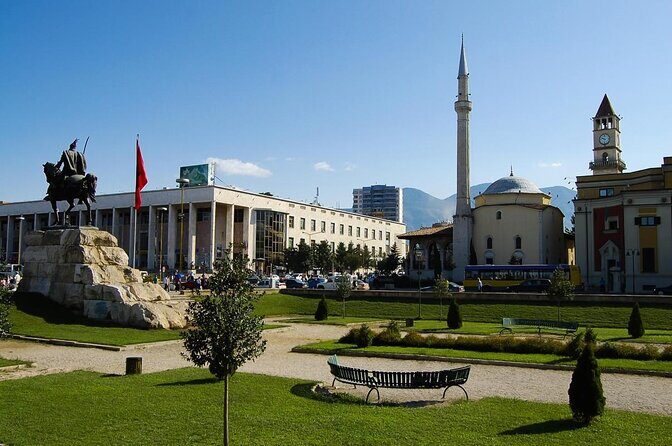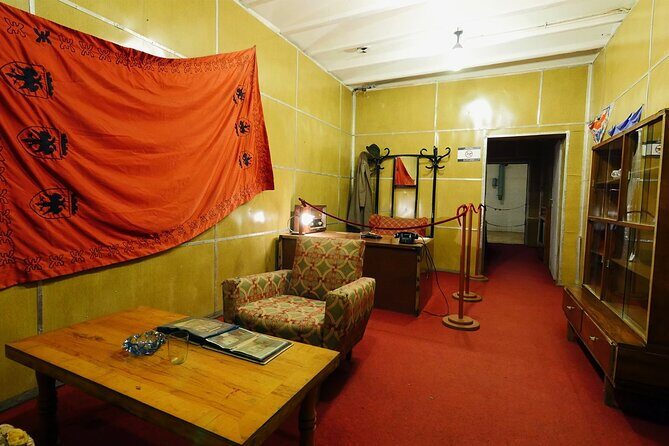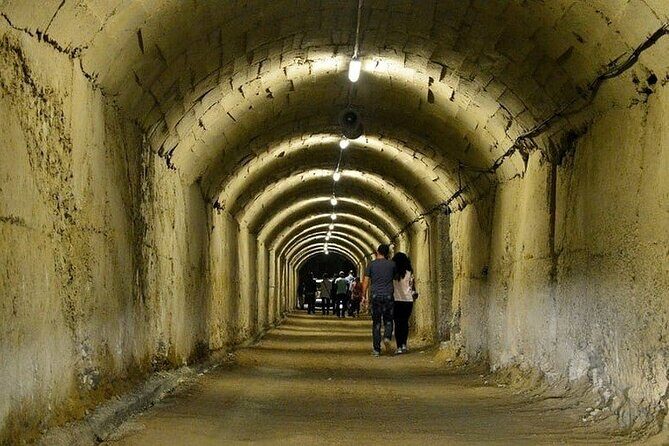Communist Traces in Tirana: A Deep Dive into Albania’s Recent Past
If you’re curious about how a country’s history can shape its streets and culture, this tour provides an eye-opening look at Tirana’s communist era. For around $116, you’ll spend roughly five to six hours uncovering the shadowy corners of Albania’s recent past, from underground bunkers to bustling squares filled with stories. Led by knowledgeable guides, this experience is designed to be both informative and engaging, blending history with authentic local flavor.
Two things we especially appreciate about this tour: the visit to Bunk Art 1, which brings the dark days of dictatorship vividly to life through underground tunnels and personal rooms of regime leaders, and the walk through Blloku, now a lively neighborhood that tells a story of transformation from secrecy to vibrancy.
A potential consideration is the pace; if you’re not a big fan of walking or prefer a more relaxed itinerary, some parts might feel brisk. But overall, this experience suits those who want a comprehensive yet accessible introduction to Albania’s recent history, especially if you’re intrigued by political history or love exploring places where the past and present collide.
Key Points

- In-depth exploration of Albania’s communist era through museums and historic sites.
- Visiting Bunk Art 1 and 2 offers unique underground perspectives on the regime’s infrastructure.
- Walking through Tirana’s main squares and neighborhoods reveals the city’s layered history and modern revival.
- Authentic local experience ending in a communist-era themed bar with traditional raki.
- Group size limited to 15 ensures a more intimate and personalized tour.
- Good value considering all included tickets, transportation, and a certified guide.
Discovering Tirana’s Communist Past: A Practical and Authentic Tour

When we first set out to explore Tirana’s communist history, we were struck by how this tour balances storytelling with physical exploration. It’s not just about looking at old buildings or reading plaques; it’s about walking through spaces that have witnessed some of the most dramatic chapters of Albanian history. The tour’s structure is well-planned, covering landmarks, museums, and neighborhoods, giving us multiple angles from which to understand this complex past.
Planning more time in Tirana? We've covered other experiences worth considering.
Starting Point: Skanderbeg Square
Our journey begins in the bustling Skanderbeg Square, the heart of Tirana. Standing amidst historic buildings, we get a sense of the city’s layered past. We are introduced to Et’hem Bey Mosque, the oldest structure in Tirana, decorated with intricate designs that tell stories of cultural resilience. Just nearby, the Clock Tower and grand government buildings like the Palace of Culture and the National Museum set a scene that mixes old traditions with the modern Albanian identity.
Walking here, we appreciated how accessible the city is; many sites are within walking distance, and the open space of the square invites a relaxed start to the tour. The guide explains each building’s significance, giving us context that makes the sights more meaningful—not just pretty facades but symbols of Albania’s evolving identity.
Museum of the Bank of Albania
Next, we head to the Bank of Albania Museum, where history unfolds through engaging exhibits. This part of the tour is especially valuable because it traces Albania’s journey from prehistory through to independence, monarchy, and finally communism. It’s a good primer to understand why the country’s recent history is so pivotal. The included ticket makes this seamless, allowing us to focus on the stories rather than logistics. We found the displays well-curated, with enough depth to satisfy history buffs without overwhelming casual visitors.
Bunk Art 2: The Communist Atrocities in Undercover Style
One of the tour’s highlights is the visit to Bunk Art 2, which might be the most visceral experience of the day. This former underground bunker complex is an eerie reminder of how paranoia and control shaped everyday life. Walking through its three levels, exploring personal rooms of top officials and the underground tunnels, we felt transported to a time when fear was a constant presence.
Our guide shared stories about the bunker’s purpose, making it clear how these hidden spaces were part of a larger network designed to survive nuclear threats and regime upheavals. The museum’s design, with dim lighting and authentic interiors, adds a sense of realism that photographs or words simply can’t match. This stop is both educational and a little haunting, offering a stark contrast to the vibrant city above ground.
Passing through Historic Sites
From the bunkers, we strolled through Rruga Murat Toptani, passing by the Castle of Toptani and the Prince Residence. These sites showcase Tirana’s layered history, blending Ottoman, royal, and communist influences. We also passed by government buildings like the House of Parliament and the new Mosque, still under construction, illustrating the city’s ongoing transformation.
- Berat-Durres and Belsh Lake, day tour from Tirana
- Semi-Private 2-Day Tour: Highlights of N. Macedonia & Kosovo
- Small Group Tour Albania, N. Macedonia & Greece from Tirana
- Day Tour in Berat, Unesco Heritage
- Small Group Tour of Southern Albania; Vlore, Butrint &Gjirokaster
- Private Tour from Tirana, Gjirokastër , Saranda and South Riviera
The Heart of Communism in Tirana: Bulevardi Dëshmorët e Kombit
The tour’s long walk along Bulevardi Dëshmorët e Kombit is a highlight, as it combines broad boulevard views with stories of dictatorship and subsequent change. Passing landmarks like Hoxha’s Pyramid—which was once a monument to the dictator himself—gives a tangible sense of Albania’s attempts at ideological expression. Your guide explains how this area was once off-limits to ordinary citizens, making it clear how much has changed since those days.
The Vibrant Blloku Neighborhood
No visit to Tirana discussing the communist era would be complete without a walk through Blloku. Once the exclusive enclave for regime leaders like Hoxha, it was closed off to the general public. Today, it’s the city’s most lively area, packed with cafes, bars, and shops. We loved the contrast: the imposing Hoxha’s house still stands, but now the streets buzz with life. This neighborhood perfectly illustrates Albania’s rapid cultural shift from secrecy to openness.
Wrapping Up at Bar Komiteti
Our day ends at a bar themed around the communist era, decorated with memorabilia and serving traditional raki. It’s a fun, informal way to reflect on what we’ve seen and learned. The ambiance transports you back in time, but with modern comfort—making it a fitting conclusion.
The Practicalities: What to Expect

This tour is designed for travelers who want a comprehensive look at Tirana’s recent history without feeling rushed. The private transportation ensures comfort and efficiency, especially given the city’s varied sites. The small group size (max 15) allows for more personalized attention from your certified guide, enabling questions and deeper discussion.
The inclusion of tickets for Bunk Art 1, the Historical Museum, and Bunk Art 2 makes the experience straightforward; you won’t have to worry about extra costs or lining up. The timing is well-paced, with roughly 30 minutes at each stop, giving enough time to absorb details without dragging.
The price reflects good value when you consider the comprehensive itinerary, guided commentary, and entrance fees. Also, ending with a drink at a themed bar adds a social element that many travelers enjoy.
Considerations
If you’re not a fan of walking or prefer a leisurely pace, this might feel a little brisk, especially during the longer stretches on Bulevardi or in the museum spaces. The tour is also not specifically tailored for travelers with physical disabilities, given the nature of some underground sites.
Who Will Love This Tour?
History enthusiasts, curious travelers, and those interested in political stories will find this tour especially rewarding. It offers a rare glimpse into the shadowy side of Tirana’s past, told through sites that are often overlooked. It’s also ideal for visitors who want a deep dive into Albanian culture beyond the usual sights, with a balance of education, authenticity, and fun.
Final Thoughts
The Communist Traces in Tirana tour offers a compelling, balanced view of a recent chapter in Albania’s history. By combining museum visits, walking tours, and authentic local experiences, it provides a full picture of how the communist era left its mark—and how Tirana is reshaping itself today.
If you’re interested in understanding the city beyond its colorful squares and lively neighborhoods, this tour will deepen your appreciation. It’s especially suited for those who enjoy stories of resilience, transformation, and the human stories behind political upheavals. Plus, the authentic atmosphere of the final bar keeps the experience lively and memorable.
For travelers seeking a meaningful, well-organized introduction to Tirana’s history, this tour hits the right marks—informative, engaging, and value-packed. Just wear comfortable shoes, bring your curiosity, and get ready to see Tirana through a different lens.
FAQ
Is this tour suitable for all ages?
Most travelers can participate, but it’s not recommended for those with physical disabilities due to the underground sites and walking involved.
How long does each stop last?
Each main site is allocated roughly 30 minutes, with some variation depending on interest and group pace.
Are entrance tickets included?
Yes, tickets for Bunk Art 1, the National Historical Museum, and Bunk Art 2 are included in the price.
What should I bring?
Comfortable shoes, sunscreen, and water are advisable, especially for the walking portions. Check the weather forecast for sun or rain.
Is transportation provided?
Yes, private transportation ensures a smooth experience from site to site.
Can I cancel if my plans change?
Yes, free cancellation is available up to 24 hours in advance for a full refund.
Does the tour end at the starting point?
Yes, the experience concludes back at the initial meeting point, making it easy to plan your day afterward.
More Tour Reviews in Tirana
More Tirana experiences we've covered
- Cultural Tour in Tirana including House of Leaves
- New Armed Forces Museum: Discover Albania’s Military History
- Tirana: Segway City Tour with Local Guide & Top City Sights
- “Two-Day UNESCO Heritage Tour: Berat, Gjirokastra & Butrint”
- Tirana Center Walking Tour
- Balkan Tour
- Tirana – Day Tour by ADRIATIK TOURS LLC
- Full Day Tirana City & Dajti National Park, Private Tour
- Tirana to Valbona: including Komani Lake & Shala River Tour
- Visit Albania and Montenegro
- Visit Albania and North Macedonia
- From Tirana/Durres: Riviera, Ksamil, Saranda & Blue Eye Tour
